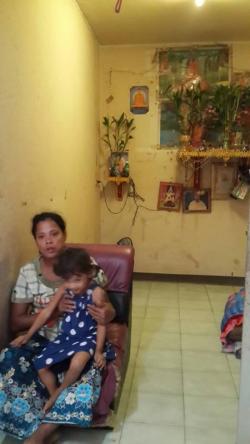
Over-crowding, poor sanitation thing of the past in dedicated zones, writes Penchan Charoensuthipan
An accommodation zone for migrant workers in Thailand, a government project piloted in Samut Sakhon and Ranong, has received positive feedback from Burmese workers who now find themselves in better and more affordable living conditions.
Khaek, a 31-year-old Burmese worker from Dawei, said she, her husband who works on a fishing trawler, and their four children live in a rented apartment at the Eua Arthorn low-cost housing project under the zoning policy in Muang district of Samut Sakhon.
Some workers recommended the place to her. The place is spacious, clean and easily accessible, said Khaek.
Her family chose a room on the first floor despite the higher rent to save themselves the trouble of walking up and down the stairs.
The monthly rent is 1,800 baht ($51), plus electricity and water bills. The family pays about 2,000 baht a month overall, which Khaek said is affordable.
“It’s a decent place to live. Our kids go to school at the St Joachim Catholic Centre for Migrants nearby and so we don’t have to worry much about them,” said Khaek.
Her family used to share a rented wooden house with a few other Burmese families before learning about the zoning policy and the housing project.
For Oo Ma Tin, 36, a Burmese worker in a seafood processing factory, the low rent at the Eua Arthorn housing project allows her and her husband, who works at a furniture company, to take turns caring for their baby and three other young children, aged four, six and 12.
“We earn enough to afford the rent. Altogether we pay about 2,600 baht a month [electricity and water bills included]. They have everything, plumbing service, minimarts, ATMs and security guards,” said Oo Ma Tin.
They are among the thousands of migrant working families based in Samut Sakhon given a government quota to live in rented flats at the Eua Arthorn housing complex run by the National House Authority (NHA).
The NHA has piloted the residential zoning programme for migrant workers in Samut Sakhon and Ranong. Eleven other provinces where migrant workers are employed will be included in the programme by April.
The other provinces are Pathum Thani, Chon Buri, Samut Prakan, Tak, Chiang Mai, Nakhon Pathom, Nonthaburi, Phuket, Songkhla, Rayong and Surat Thani.
Samut Sakhon is home to about 288,658 migrant workers, 258,767 of whom are from Burma, 10,066 from Laos and 19,825 from Cambodia.
Many previously lived in rented living quarters in a wooden house or a flat in densely populated communities of migrant workers. The crammed living conditions contributed to myriad problems, including poor sanitation.
The communities in Muang, Ban Phaeo and Krathum Baen districts in the past were a major breeding ground for diseases that also affected local Thai residents.
The zoning policy is part of a wider measure to tackle issues related to migrant workers, approved in June 2014.
A source said an executive decree is being drafted requiring employers to arrange accommodation for migrant employees within the statespecified zones, according to a labour ministry source.
Right now, the workers rent the rooms directly with the housing project or through a broker.
However, in the beginning, some Thai locals were apprehensive about the zoning, which brought many migrants to live together.
A local resident, who asked to be called Aoy, said the Eua Arthorn tenants used to be mainly Thai. When the workers moved in, she initially felt rather uncomfortable.
For instance, these workers use lots of spices when they cook, which causes a strong smell. Some also chew betel nuts and spit them out randomly, Aoy noted.
She previously occupied the flat where many migrant workers have now moved. She later moved out and went to live in another building.
The housing management decided to group migrants in buildings according to their nationalities to prevent friction. Thais were also moved to a separate building.
After that, the management asked for migrant tenants’ cooperation to deal with waste-water and the spit blamed for clogging up drains, which helped ease the problems.
Arthit Ngampornchai, manager of the Eua Arthorn housing project at the Tha Chin community in Samut Sakhon, said the project built a total of 56 buildings in 2013 but they did not sell well in the beginning.
In most buildings, there were many empty rooms. The situation turned around when the residential zoning programme for migrant workers was introduced, he said.
The project joined the programme and rented out the rooms, which saw those vacancies fill up fast.
Labour Minister General Sirichai Distakul said the government aims to regulate the housing of migrant workers to improve their quality of life.
The education ministry also helped arrange for basic education to be given to migrant workers’ children from Burma, he said. Thailand currently employs about 2.6 million migrant workers from Burma, Laos and Cambodia.
About 1.29 million of them are legal workers and about 1.32 million are allowed to work here pending a nationality verification process that is required before they can obtain legal migrant worker status.
By: Penchan Charoensuthipan, Bangkok Post
Published on: 15 February 2017
